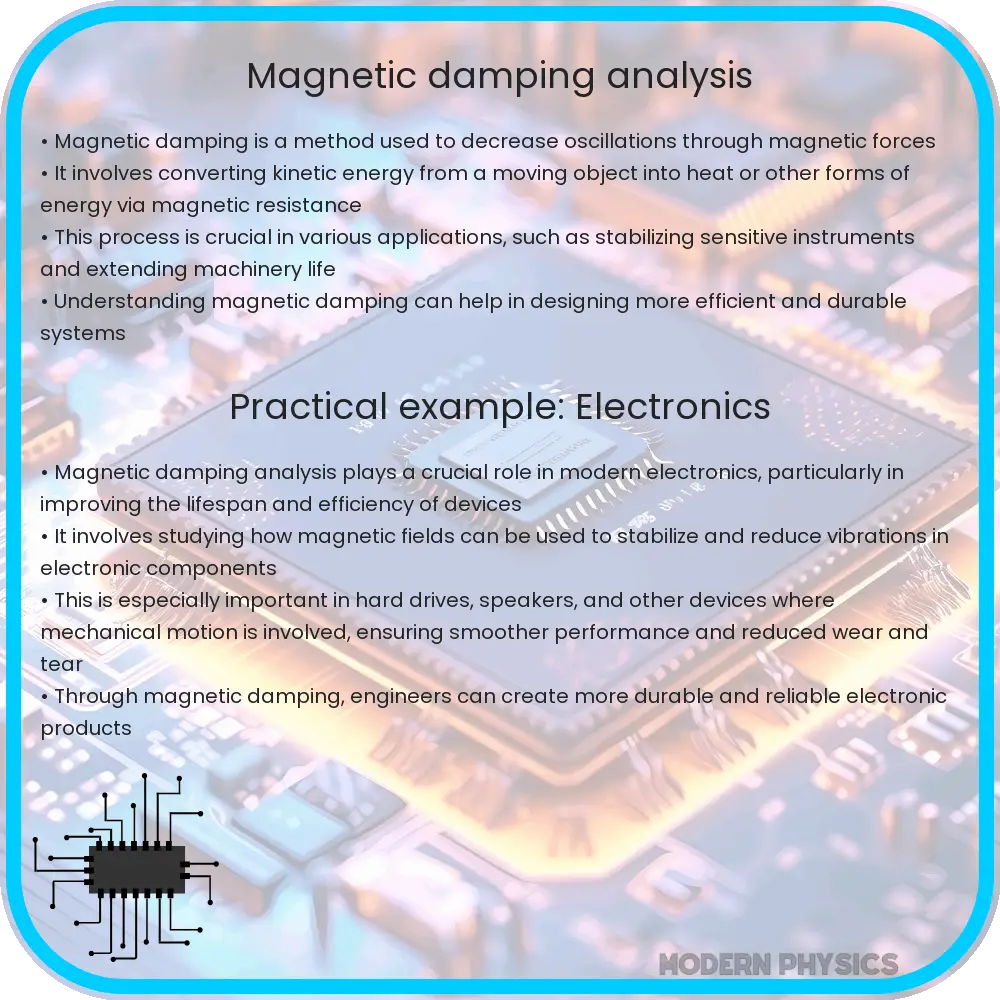Explore the essentials of magnetic damping: techniques, efficiency, and impact in industrial and electronic applications for optimal performance.

Magnetic Damping: An Overview
Magnetic damping is a phenomenon that involves the dissipation of energy within a magnetic system. This process plays a crucial role in various applications, from industrial machinery to electronic devices. Understanding the techniques used in magnetic damping, its efficiency, and the impact it has on different systems is vital for optimizing performance and extending the lifespan of equipment.
Techniques of Magnetic Damping
There are several techniques used to achieve magnetic damping, each with its unique mechanism and applications:
- Eddy Current Damping: This technique involves the creation of eddy currents in a conductor moving through a magnetic field. The interaction between the magnetic field and the eddy currents generates a damping force that opposes the motion, thus dissipating energy.
- Hysteresis Damping: Hysteresis damping occurs in ferromagnetic materials. When these materials are subjected to a changing magnetic field, the lag in magnetization causes energy dissipation in the form of heat, providing a damping effect.
- Viscous Damping: Though not strictly magnetic in nature, viscous damping can be enhanced by magnetic fields. It involves the resistance experienced by an object moving through a fluid, which can be controlled using electromagnets to adjust the fluid’s viscosity.
Efficiency of Magnetic Damping
The efficiency of magnetic damping is determined by how effectively it converts kinetic energy into other forms of energy, typically heat. Factors influencing this efficiency include:
- The strength and orientation of the magnetic field.
- The electrical conductivity and magnetic properties of the materials involved.
- The speed and nature of the moving parts.
For example, in eddy current damping, higher conductivity materials generate stronger eddy currents, resulting in more effective damping. Similarly, the efficiency of hysteresis damping is influenced by the material’s magnetic saturation and coercivity.
Impact of Magnetic Damping
Magnetic damping has significant implications in various fields:
- Industrial Applications: It’s used in machinery to reduce vibrations and noise, enhancing operational stability and reducing wear and tear.
- Electronics: Magnetic damping is critical in hard drives and other electronic components where precision and control are paramount.
- Transportation: In vehicles and trains, magnetic damping systems contribute to smoother rides and increased safety.
Understanding these impacts is essential for designing systems that effectively utilize magnetic damping to enhance performance and durability.
Advancements in Magnetic Damping Technology
Recent advancements in magnetic damping technology have led to significant improvements in various sectors. Innovations in material science, such as the development of advanced ferromagnetic materials and conductive composites, have enhanced the efficiency and applicability of magnetic damping systems. Additionally, the integration of computer-controlled electromagnets allows for real-time adjustment of damping forces, catering to dynamic operational needs.
Challenges and Future Directions
Despite its many benefits, magnetic damping faces challenges that need to be addressed. One major challenge is heat dissipation in high-energy applications, which can affect the system’s efficiency and longevity. Additionally, the cost and complexity of implementing advanced magnetic damping systems can be prohibitive for some applications. Future research is focusing on developing cost-effective, high-performance materials and designs that can withstand extreme conditions while maintaining efficiency.
Environmental Impact and Sustainability
Magnetic damping technology also plays a role in environmental sustainability. By reducing mechanical wear and energy consumption in machinery, it contributes to longer equipment lifespans and lower energy usage. Furthermore, as industries move towards greener practices, magnetic damping can be a key component in developing eco-friendly technologies, such as in wind turbines and electric vehicles, where efficient energy management is critical.
Conclusion
Magnetic damping is a vital technology with a wide range of applications, from industrial machinery to transportation and electronics. Its ability to efficiently dissipate energy and minimize wear and tear makes it an invaluable tool in enhancing system performance and longevity. The ongoing advancements in materials and control technologies promise even greater efficiencies and applications in the future. However, challenges like heat management and cost need to be addressed to fully realize its potential. As industries continue to evolve, magnetic damping stands as a cornerstone technology in the pursuit of efficiency, sustainability, and innovation.
